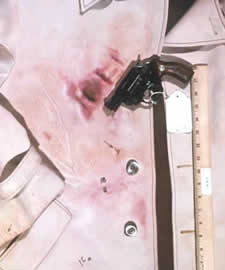- 01: Introduction
- 02: History
- 03: Propellants, Firearms, and Ammunition Development
- 04: Modern Firearms Manufacture
- 05: Small Arms Ammunition
- 06: Evidence Handling Procedures
- 07: Equipment and Instrumentation
- 08: Examination of Firearms
- 09: Cartridge and Shotshell Examination
- 10: Characterization and Evaluation of Fired Projectiles
- 11: Bullet Comparison and Identification
- 12: Gunshot Residue and Distance Determination
- Introduction
- Objectives
- AFTE Knowledge and Ability Factors
- Powders and Residues
- Examination
- Distance Determination
- Significance of Results
- Contact Shot
- Nitrite Residues
- Vaporous Lead Residues
- Residues Consistent with the Passage of a Bullet
- Residues Consistent with the Discharge of a Firearm
- Interpretation Challenges
- Reproduction of Results
- Nitrite Residue Patterns
- Shot Patterning
- Chemical Testing
- Shot Pattern Reproduction
- Selected Bibliography
- 13: Toolmark Identification
- 14: Communicating Results
- Resources


Sodium Rhodizonate Test
Home > Gunshot Residue and Distance Determination > Examination > Chemical Testing > Sodium Rhodizonate Test

Blue-violet positive result for the Sodium
Rhodizonate Test for lead with the
evidence
revolver, showing cylinder blast and muzzle blast
The Sodium Rhodizonate Test is a chemically specific chromophoric test for the presence of lead in any form, including vaporous lead (smoke), particulate lead, lead in primer residues (e.g., lead azide or lead styphnate), lead bullet, or shot pellet wipe. The presence of particulate lead is a random nonreproducible phenomenon dependent on many uncontrolled variables that may be caused by leading, metal fouling, or a dirty barrel at the time of discharge.
The presence of vaporous lead is very useful in that it typically is found at closer ranges. Although the Sodium Rhodizonate Test cannot be used to determine precise muzzle-to-target distances, it is possible to determine the maximum distance to which it will be deposited using the firearm and ammunition in combination.
The procedure can be applied to a number of surfaces, such as victim clothing, drywall, vehicle upholstery, curtains, carpet, etc. It is always performed after the Modified Griess Test and the Dithiooxamide Test to preclude potential chemical interference.
The objective of this test is to confirm the results of the Modified Griess Test. Information from this test may also assist in establishing a muzzle-to-target distance; lead is generally detected at closer distances. A positive result around the suspected bullet hole is consistent with passage of a bullet.




